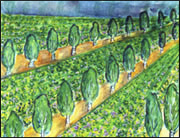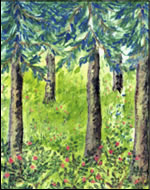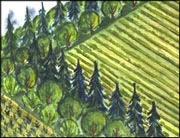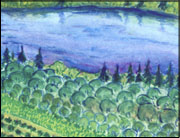Agroforestry
Agroforestry is a set of land management practices used around the world. They encompass the intentional integration of trees or shrubs with other crops or livestock. The five agroforestry systems commonly used in temperate agroforestry include: silvopasture, alley cropping, agricultural riparian buffers, forest farming/food forests, and shelterbelts/vegetative buffers.
There are regional variations reflecting Temperate and Tropical systems. Definitions in use in British Columbia follow North American conventions, the context of which is the integration of agronomic principles, practices and production with both forestry and conservation management approaches.
By leveraging the advantages of integration, agroforestry systems can yield a variety of benefits, including production gains, economic and social benefits, enhanced environmental function (e.g. conservation of soil, water, air and biodiversity) and climate change mitigation and adaptation benefits.
Operationally, implementation might involve design and establishment starting from a blank slate. However, it more commonly evolves from:
- deliberately retaining or adding trees or shrubs into existing crop or livestock focused agricultural production systems; or
- deliberately adding or enhancing crop or livestock management in forest production systems
Agroforestry farm practices
Basic factors of agroforestry systems
Intentional: Systems are planned, designed and managed for a combination of crops, livestock and trees while simultaneously providing environmental and social benefits.
Integrated: Systems are a blend of agriculture, forestry and conservation management practices and outcomes.
Interactive: Systems are designed to minimize negative and maximize positive interactions among trees, other crops, livestock and humans.
Intensive or extensive: Management will typically be more intensive than conventional management approaches as additional complexity is introduced with integration. However, management intensity will vary depending on the system design and desired outcomes.

Silvopasture in BC
Silvopasture blends trees, forages, and livestock managed as an integrated practice on the same land unit. These systems are purposefully managed for forage, livestock and forest products, or shrubs, fruit and nut trees. Silvopastures can be created by introducing or augmenting existing forages in treed systems or by introducing trees into pasture systems. In B.C., the use of silvopasture practices is typically supplementary to conventional forestry, range and pasture management. Silvopasture is not defined by grazing and forage production in the presence of trees and shrubs. Rather, all components (the livestock, forages and woody perennials) are combined through careful planning, implementation and management practices considering each of the elements and their potential interactions.
Examples might include grazing sheep or cattle among Christmas trees for competition management; beef cattle managed to graze fine fuels in the understory for wildfire risk reduction; adding forage, off stream water and retained shade to young forested grazing sites to attract livestock away from riparian zones; and, poultry use in orchards to reduce forage competition and consume insect pest and weed seeds.
Managing interactions
One way to view silvopasture is that it is about managing interactions. At a base level there are interactions between the trees and forage, forage and livestock, and livestock and trees. The interactions and effects on one another will shift over time with each having greater or lesser impacts on site resources depending on the stage of the silvopasture development.
Herbaceous Phase: Trees, shrubs and forages can all be directly impacted by livestock. Forages (seeded or native) may dominate the site with trees and shrubs competing for light, and soil resources.
Intermediate Phase: The tree and shrub canopies are at a stage where they no longer compete with the forage layer for light. Competition or facilitation for soil resources can be prominent. Livestock interact with and impact the forage layer, but their impacts on trees and shrubs is usually limited to physical impacts from rubbing or stepping on large surface roots.
Arboreal Phase: Mature trees and shrubs are of sufficient size that they control the availability of both above and below-ground resources. They exert a strong influence on the site by influencing temperatures, wind and heating. Livestock have limited to no impact on the tree and shrub layers, except for woody species that have a high concentration of surface or shallow roots which may be impacted by compaction or physical root damage.
Silvopasture resources
Coming soon. Factsheets, reports, webinars and video clips will be uploaded to this site over the next few months as material produced from collaborative pilots, demonstrations and other projects becomes available.
What is Silvopasture
Cariboo Silvopasture Demonstrations, Planning for Silvopasture Applications on Private land
Silvopasture in British Columbia information series
The series is a set of modules covering basic, intermediate and advanced topics. The infographic illustrates the major sections of information including:
- core units which outline the basics of silvopasture - what it is, why it might be and has been used, the science behind it, common management practices, and planning;
- case studies illustrating some of the concepts of the core units and highlighting producer experiences; and,
- supplemental units which support the core units by going into greater depth on some topics such as light and hydrology.
Each module introduces a new topic or provides real-world examples from BC and further detail which illustrate and reinforce the information covered in prior modules. Readers can follow along sequentially or hop around among the topics based on interest and experience. In essence the series is designed for on-demand self study. Alternatively, they may be used as the foundation for in-person or webinar workshop events as interest dictates.
Modules are designed as PowerPoint presentations and will gradually be added below over the next few weeks as both PDFs and narrated presentations (mp4).
| Core units | Case studies | Supplemental units |
|---|---|---|
| Series Overview: Slide deck (PDF, 1.1 MB) | Annotated deck (PDF, 1.1 MB) | Narrated presentation (mp4) | ||
Introduction
|
History of Silvopasture in B.C.
|
|
Science Behind Silvopasture
|
Production Synergies: Kootenay Tree Farms
|
Light and Microclimate Hydrology
Hydrology
|
Silvopasture Beneficial Management Practices – Part 1
Silvopasture Beneficial Management Practices – Part 2
|
Small-lot Silvopasture: Just Another Weed Patch Farm
Mature forest to Silvopasture: Indian Gardens Ranch
|
Managing damage
|
Silvopasture Planning
|
Silvopasture Pilot Project – Collaborative Crown Land Example
Adaptive Management at Aveley Ranch
|
|
Other agroforestry systems in B.C.
Combining agriculture, silviculture and conservation practices in the same land use system. Five main agroforestry systems are practical for use in British Columbia:

Alley cropping
Alley cropping is an agroforestry system broadly defined as the planting of single or multiple rows of trees and/or shrubs at wide spacings to create alleyways within which crops are cultivated. Both the crops and trees, or their products, can be harvested. Trees or shrubs are spaced to provide high light levels to the crops between them. This system suits crops that require more sun to mature and become marketable. An alley cropping example might consist of rows of trees for wood or other tree products (e.g. nuts or fruit), grown in conjunction with horticultural crops (e.g. vegetables) or field crops.

Forest farming / food forests
Forest farming is an agroforestry system broadly defined as the integrated management of both tree and understory crops; it focuses on managing a stand to benefit both the trees and the understory (plants growing under the tree canopy). It is the practice of intentionally managing site resources (e.g. light levels), and growth stages of the tree and understory plants for production, environmental and social values.

Shelterbelts / Vegetative buffers
Vegetative buffers are broadly defined as single to multi-row linear features of trees and/or shrubs. They may take the form of windbreaks, shelterbelts, hedgerows etc; and are designed to perform specific jobs. Site conditions and desired function affect the design and application, and help to determine the key features of the planting.
Tree and shrub plantings are designed to provide environmental goods and services, as well as economic, and social benefits. Benefits might include enhanced crop production (e.g. via shelterbelts for microclimate modification), reduced soil erosion (wind interception), protection of people and livestock (e.g. yardsite or livestock buffers for summer shade or reduced winter heat losses), lateral light interception (e.g. from greenhouses), dust and odour mitigation, interception of pesticide drift and water conservation

![]()
Programs are available to support the agriculture and agrifood industry:
Contact information
Agroforestry questions
Lisa Zabek
Agroforestry Specialist, Interior B.C.
250 312-7277
Lisa.Zabek@gov.bc.ca
